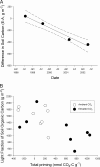Altered soil microbial community at elevated CO(2) leads to loss of soil carbon
- PMID: 17360374
- PMCID: PMC1820881
- DOI: 10.1073/pnas.0610045104
Altered soil microbial community at elevated CO(2) leads to loss of soil carbon
Abstract
Increased carbon storage in ecosystems due to elevated CO(2) may help stabilize atmospheric CO(2) concentrations and slow global warming. Many field studies have found that elevated CO(2) leads to higher carbon assimilation by plants, and others suggest that this can lead to higher carbon storage in soils, the largest and most stable terrestrial carbon pool. Here we show that 6 years of experimental CO(2) doubling reduced soil carbon in a scrub-oak ecosystem despite higher plant growth, offsetting approximately 52% of the additional carbon that had accumulated at elevated CO(2) in aboveground and coarse root biomass. The decline in soil carbon was driven by changes in soil microbial composition and activity. Soils exposed to elevated CO(2) had higher relative abundances of fungi and higher activities of a soil carbon-degrading enzyme, which led to more rapid rates of soil organic matter degradation than soils exposed to ambient CO(2). The isotopic composition of microbial fatty acids confirmed that elevated CO(2) increased microbial utilization of soil organic matter. These results show how elevated CO(2), by altering soil microbial communities, can cause a potential carbon sink to become a carbon source.
Conflict of interest statement
The authors declare no conflict of interest.
Figures


References
-
- Cramer W, Bondeau A, Woodward FI, Prentice IC, Betts RA, Brovkin V, Cox PM, Fisher V, Foley JA, Friend AD, et al. Global Change Biol. 2001;7:357–373.
-
- Ainsworth EA, Long SP. New Phytol. 2005;165:351–371. - PubMed
-
- Jastrow JD, Miller RM, Matamala R, Norby RJ, Boutton TW, Rice CW, Owensby CE. Global Change Biol. 2005;11:2057–2064. - PubMed
-
- Cheng WX. Tree Physiol. 1999;19:313–320. - PubMed
Publication types
MeSH terms
Substances
LinkOut - more resources
Full Text Sources
Other Literature Sources
Medical

